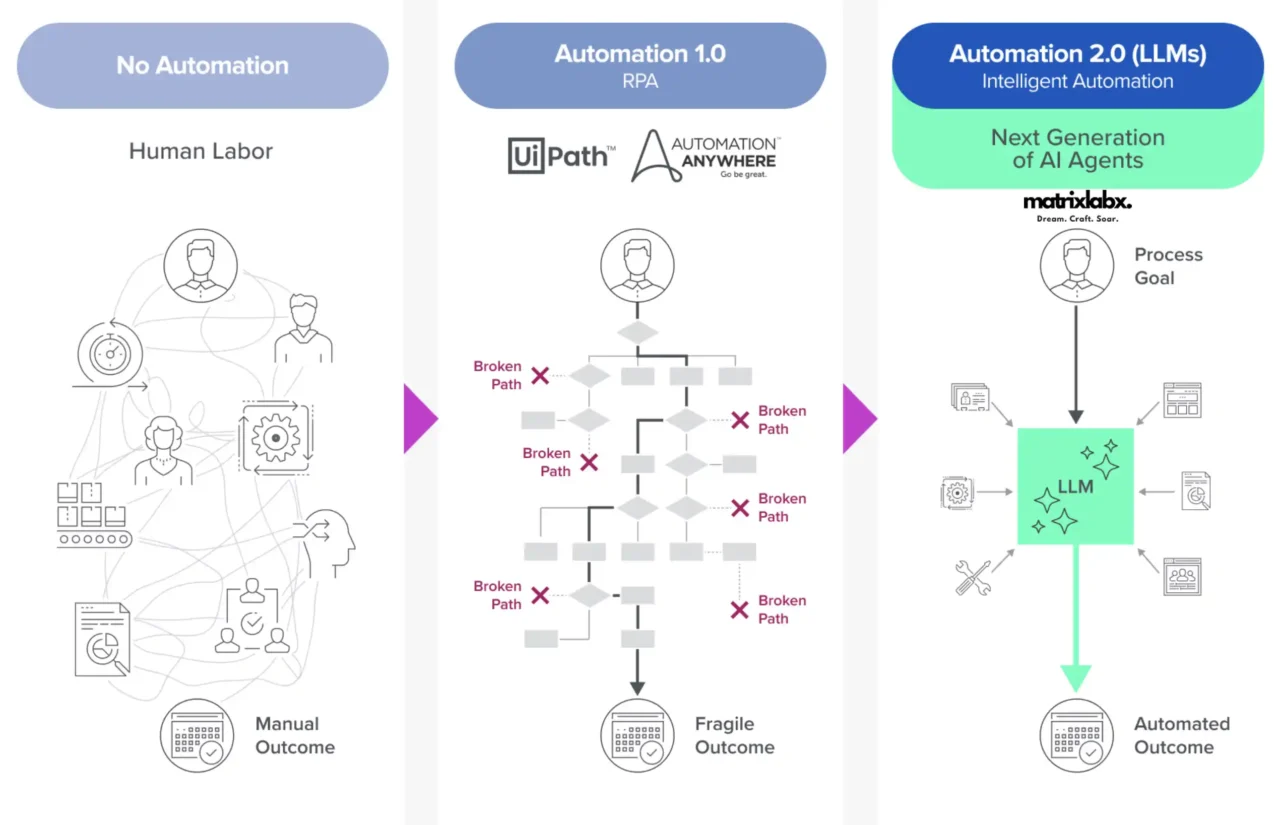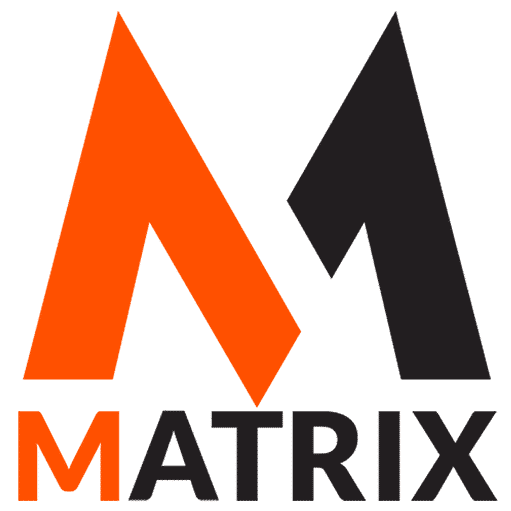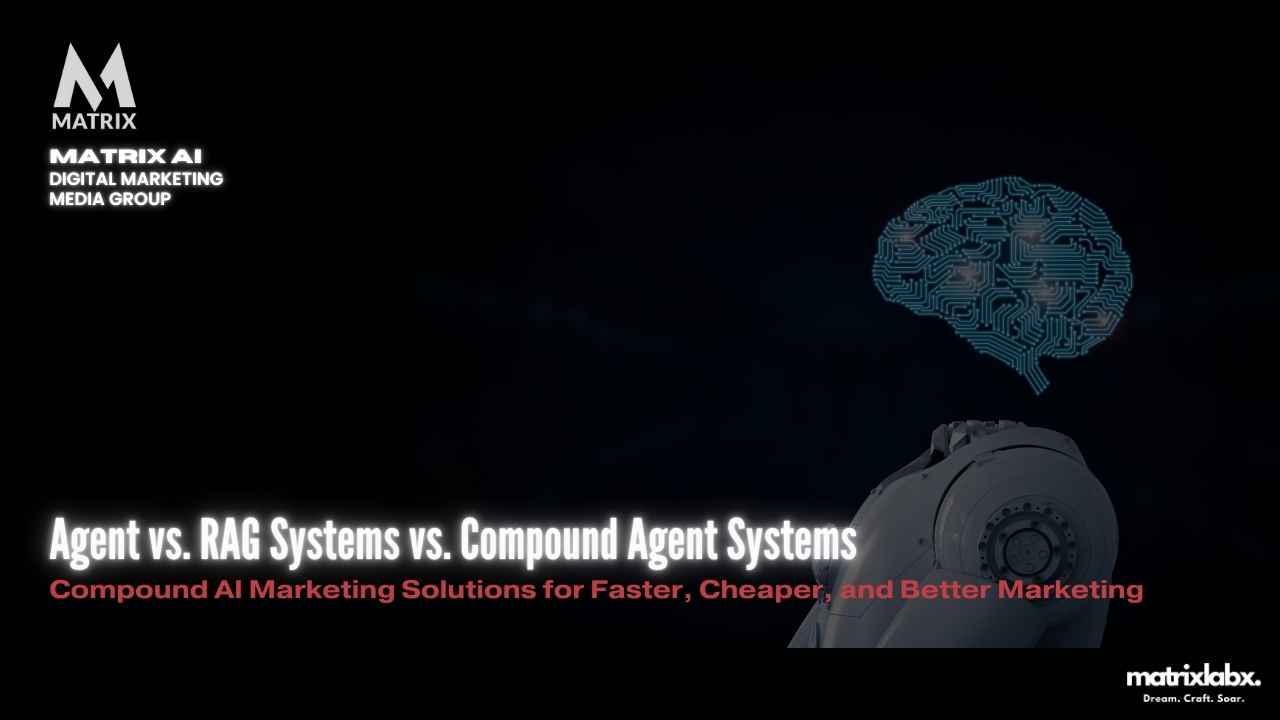Agent vs. RAG Systems vs. Compound Agent Systems: Choosing the Right Technology for Marketing Success
Learn About Agent vs. RAG Systems vs. Compound Agent Systems: Choosing the Right Technology for Marketing Success.
Achieving a $1:$20 ROI in Less Than 3 Months with Compound Agent Systems by MatrixLabX
John Matthews, the CMO of a mid-sized eCommerce company specializing in outdoor gear, faced increasing pressure to maximize ROI from his marketing budget.
Traditional strategies like pay-per-click advertising and email campaigns delivered diminishing returns while scaling his team to explore new approaches wasn’t feasible within his budget constraints.
John needed a solution that could integrate seamlessly into his existing operations, amplify productivity, and deliver measurable outcomes—all without adding significant overhead. That’s when he discovered Compound Agent Systems from MatrixLabX, powered by their OrchestraAI platform.
Challenge
John’s team had to deliver results across multiple channels—SEO, paid media, social media, and email—while managing a growing customer base.
Despite their best efforts, manual processes limited their ability to optimize campaigns, personalize outreach, and scale marketing efforts efficiently. Additionally, John’s CEO demanded a clear ROI demonstration within a strict three-month timeframe.
Solution
John implemented Compound Agent Systems from MatrixLabX. These AI-driven, autonomous agents were preconfigured to work collaboratively across marketing functions, including:
- Predictive Campaign Optimization: Analyzing data in real-time to reallocate budgets to the highest-performing channels automatically.
- Content Personalization at Scale: Generating dynamic, hyper-personalized marketing messages based on customer behavior.
- 24/7 Marketing Execution: Operating continuously without human intervention, ensuring no missed opportunities.
Within the first week, the OrchestraAIsystem onboarded seamlessly, integrating with John’s CRM, ad platforms, and analytics tools.
Execution
The Compound Agents began executing marketing tasks immediately:
- Paid Advertising Agent: Optimized ad copy and targeting, reducing cost-per-click by 40%. AIAdPad
- Email Marketing Agent: Created and deployed segmented campaigns with AI-generated personalized content, increasing open rates by 50%.
- SEO Agent: Identified high-value keywords and generated optimized content, boosting organic traffic by 30%. AISEOPad.
- Data Insights Agent: Continuously analyzed campaign performance and recommended real-time adjustments, ensuring resources were allocated effectively.
- Social media marketing with AISocialPad.
Results
Within two months, John started seeing dramatic results:
- The system drove a 200% increase in sales conversions from personalized email and paid media campaigns.
- Advertising spending efficiency improved, with the cost per acquisition (CPA) dropping by 45%.
- Organic search traffic surged, accounting for 25% of total revenue.
- John’s team saved over 100 monthly hours by delegating repetitive tasks to the autonomous agents.
By the end of three months, the eCommerce company achieved a $1:$20 ROI, meaning for every dollar spent on the MatrixLabX solution, the business earned $20 in revenue.
MatrixLabX’s Compound Agent Systems was a game-changer for John’s team. Not only did they meet the CEO’s demand for a clear ROI within three months, but they also set the foundation for sustained, scalable growth. Freed from manual tasks, John’s team could focus on strategic initiatives while the AI agents continued to optimize and execute with precision.
Key Takeaway: With Symphony AI and Compound Agent Systems, businesses like John’s can unlock exponential marketing performance and redefine what’s possible with limited resources—all while delivering unparalleled ROI.
Agent Systems, RAG (Retrieval-Augmented Generation) Systems, and Compound Agent Systems

Agent Systems:
Think of an agent as a hotel concierge. The concierge listens to your request, uses their expertise and tools to fulfill it (like booking a restaurant or providing directions), and delivers the result.
They operate independently within the scope of their training and tools.
- Key Attribute: Self-contained and task-focused, using predefined capabilities to achieve goals.
RAG Systems:
A RAG system is like a research assistant with access to a vast library. When you ask a question, the system searches through books, articles, and databases to retrieve the most relevant information, synthesize it, and provide a tailored answer.
They excel at combining pre-existing knowledge with dynamic retrieval.
- Key Attribute: Combines generative abilities with external, up-to-date information for high-context tasks.
OrchestraAI Marketing Platform – WATCH
OrchestraAI utilizes a compound AI agent architecture as an AI Agentic Platform. This architecture seamlessly integrates multiple specialized AI agents into a cohesive system, enabling it to tackle complex, multifaceted marketing tasks.

Compound Agent Systems:
A compound agent system is like a team of specialized professionals working together on a complex project. OrachestraAI from MatrixLabx is a perfect example of a Compound Agent System for marketing.
Each member (or agent) has a specific role (e.g., planning, research, execution) and communicates with others to meet the overall objective.
The system’s strength lies in its ability to orchestrate multiple agents with different capabilities to achieve complex, multi-step goals.
- Key Attribute: Collaboration and specialization across multiple agents, resulting in more sophisticated and flexible problem-solving.
This analogy illustrates the progression from individual focus (Agent Systems) to information-enhanced intelligence (RAG Systems) to integrated, multi-agent orchestration (Compound Agent Systems).
In today’s fast-paced digital marketing landscape, Chief Marketing Officers (CMOs) are tasked with making sense of increasingly complex technologies to gain a competitive edge.
70% of agencies need help integrating AI solutions.
70% of agencies need help integrating AI solutions into their tech stack, citing a lack of interoperability as a major barrier. 85% of marketing agencies need more in-house expertise to manage and deploy multi-AI agent systems effectively.
Among the most transformative innovations are Agent Systems, Retrieval-Augmented Generation (RAG) Systems, and Compound Agent Systems.
Each of these technologies offers unique capabilities, but understanding their differences, strengths, and limitations is key to leveraging them effectively.
This article will explore these systems in-depth, providing insights for CMOs looking to enhance their marketing strategies.
What Are Agent Systems?
Agent Systems represent a class of intelligent software entities designed to perform specific tasks autonomously.
These systems are modeled to simulate human-like decision-making, making them invaluable in applications requiring real-time adaptation and personalized interactions.
Core Principles of Agent Functionality
Three primary characteristics define agent systems:
- Autonomy: Agents operate independently, reducing the need for continuous human oversight. For CMOs, this translates to efficiency in managing repetitive tasks like automated email campaigns or social media monitoring.
- Goal-Orientation: Agents are task-specific and programmed to achieve defined objectives. For example, a marketing agent might focus on optimizing customer segmentation.
- Adaptivity: Agents can learn and evolve from interactions. This is critical for CMOs looking to deploy solutions that improve over time, such as personalized customer experiences.
Strengths and Limitations of Agent Systems
Agent systems excel in scenarios requiring decentralized decision-making and personalized interactions.
However, they often struggle with scalability and coordination when multiple agents operate in complex environments—a limitation that CMOs must consider when integrating these systems into broader campaigns.
What Are Retrieval-Augmented Generation (RAG) Systems?
RAG Systems combine two powerful elements: data retrieval and generative AI.
These systems are particularly adept at creating content or providing insights based on a vast knowledge repository, making them invaluable for content-driven marketing strategies.
The Skill Gap: Why 85% of Marketers Are Not Ready
The Skill Gap: Why 85% of Marketers Are Not Ready highlights the urgent need for upskilling in a rapidly evolving digital landscape. Advanced technologies like AI, data analytics, and automation are outpacing traditional marketing expertise, leaving most professionals unprepared to adapt and compete effectively.
Core Components of RAG Systems
- The Retrieval Mechanism: This component pulls relevant data from knowledge bases or external sources. CMOs can use this feature to create data-driven content, ensuring accurate and timely marketing materials.
- Generation Model: The generative component creates contextually relevant outputs, such as blog articles or ad copy, enhancing a brand’s voice and message consistency.
- Integration Process: Seamless integration between retrieval and generation ensures that outputs are well-informed and actionable.
Advantages and Disadvantages of RAG Systems
RAG systems’ ability to create high-quality, context-aware content sets them apart.
However, reliance on the quality and availability of external data sources can create bottlenecks, making it essential for CMOs to vet data integrations carefully.
What Are Compound Agent Systems?
Compound Agent Systems merge the functionalities of individual agents and RAG systems into a cohesive framework.
These systems operate across layers, combining the strengths of autonomous agents and retrieval-based systems for complex, large-scale tasks.
Structural Components of Compound Agent Systems
- Layered Architectures: These systems include simple agents for task automation and complex agents for strategic functions, ensuring scalability and versatility.
- Interaction Protocols: Protocols manage how different agents communicate, allowing seamless coordination—a crucial factor for CMOs juggling multiple marketing initiatives.
- Workflow Synchronization: These systems ensure tasks are completed in a coordinated, timely manner, enhancing campaign efficiency.
Benefits and Drawbacks of Compound Agent Systems
Compound systems are ideal for large-scale, multi-channel marketing campaigns. However, their complexity demands robust design and maintenance, posing challenges for CMOs without dedicated technical resources.
Comparing Agent Systems, RAG Systems, and Compound Systems
When evaluating these technologies, CMOs must consider the following:
- System Design Philosophy: Agent systems excel in targeted tasks, RAG systems specialize in contextual output, and compound systems shine in orchestrating multi-layered strategies.
- Performance Metrics: Each system’s effectiveness depends on specific use cases. CMOs should align these metrics with campaign goals.
- Scalability and Adaptability: Compound systems provide the most scalability, while agents and RAG systems cater to more niche applications.
Use Cases of Agent Systems
For CMOs, agent systems are transformative in the following scenarios:
- Autonomous Campaign Management: These systems can execute marketing workflows without manual intervention, such as scheduling social media posts or running A/B tests.
- Customer Engagement: Chatbots powered by agent systems can handle inquiries, provide personalized recommendations, and gather data for future campaigns.
- Predictive Analytics: By analyzing historical data, agents can forecast trends, helping CMOs allocate resources effectively.
Use Cases of RAG Systems
RAG systems are particularly suited for content-intensive marketing activities:
- Content Creation: These systems can generate high-quality blog posts, whitepapers, and ad copy tailored to specific audiences.
- Market Research: CMOs can leverage RAG systems to synthesize industry reports, gaining actionable insights without extensive manual effort.
- Customer Support: RAG systems enable the creation of knowledge-based answers, enhancing customer service experiences.
Use Cases for Compound Agent Systems in Marketing Operations
Compound systems offer unparalleled capabilities for CMOs managing complex marketing ecosystems:
- Omni-Channel Campaigns: These systems ensure consistent messaging across platforms, coordinating tasks like email, social media, and digital ads.
- Crisis Management: Compound systems can rapidly adapt to unforeseen events, ensuring continuity in brand communication.
- Integrated Analytics: These systems provide unified dashboards combining insights from diverse channels, enabling data-driven decision-making.
1. Campaign Management
- Coordinating a multi-channel marketing campaign is overwhelming, with tasks scattered across email, social media, paid ads, and analytics tools. Deadlines are missed, and errors creep in.
- Delays and inconsistencies lead to poor campaign performance, wasted budget, and missed opportunities to engage the target audience effectively.
- A compound agent system orchestrates campaign tasks across channels, ensuring every agent completes its role on time, integrates data for real-time updates, and adapts strategies dynamically.
2. Content Personalization
- Manual processes make personalizing content for multiple audience segments at scale nearly impossible, leading to generic, ineffective messaging.
- Audiences disengage due to irrelevant messaging, reducing campaign ROI and customer satisfaction. Competitors offering better personalization win the market.
- A compound agent system automates audience segmentation, tailors messages for each group, and tests variations to ensure optimized engagement across all touchpoints.
3. Performance Analysis and Optimization
- Analyzing performance metrics across platforms is time-consuming, and insights are often delayed or incomplete. Thus, marketers miss opportunities to optimize campaigns in real time.
- Delayed analysis leads to prolonged underperformance, wasting ad spend and lowering the overall campaign impact.
- A compound agent system monitors platform performance, integrates metrics into a unified dashboard, and automatically adjusts campaigns to capitalize on high-performing strategies.
4. Social Media Management
- Managing multiple social media accounts, posting content, responding to queries, and monitoring trends demand constant attention and coordination.
- Inconsistent posting schedules and slow responses to customer queries hurt brand visibility and engagement.
- Compound agents schedule posts, track engagement trends, and respond to customer interactions in real time, maintaining consistent and active brand presence without human intervention.
5. Marketing Budget Allocation
- Allocating budgets effectively across multiple campaigns and channels is complex, and there is no clear visibility into which channels yield the highest ROI.
- Poor budget decisions waste resources on low-performing channels, reducing overall marketing efficiency and impact.
- A compound agent system analyzes campaign performance, calculates ROI per channel, and reallocates budgets dynamically to maximize results.
6. Lead Nurturing and Conversion
- It is challenging and labor-intensive to follow up with leads at the right time and deliver tailored content to move them through the funnel.
- Leads drop off due to delayed follow-ups or irrelevant messaging, causing revenue loss and lower conversion rates.
- Compound agents automate lead nurturing workflows, delivering personalized content optimally to keep prospects engaged and drive conversions.
7. Crisis Management
- It is difficult to coordinate the right messaging across platforms when responding quickly to PR crises or sudden market shifts.
- Delayed or inconsistent crisis responses can damage brand reputation and lose customer trust.
- Compound agent systems monitor sentiment in real time, craft appropriate responses, and deploy them across channels instantly, mitigating reputational risks.
8. Competitor Monitoring
- Staying updated on competitor strategies requires continuous monitoring, which is time-consuming and prone to oversight.
- Missed opportunities to counteract competitors’ moves weaken market positioning and strategy effectiveness.
- Compound agents track competitors’ activities, analyze their strategies, and recommend adjustments to the user’s campaigns, maintaining a competitive edge.
9. E-commerce Campaign Optimization
- Managing product promotions, optimizing pricing, and updating ad creatives for e-commerce platforms is tedious and prone to errors.
- Inefficient management leads to lost sales opportunities and reduced market share.
- Compound agents optimize product listings, test different ad creatives, and adjust pricing strategies based on sales data and market trends.
These use cases illustrate how compound agent systems address specific pain points in marketing operations, automate workflows, and deliver scalable, data-driven solutions for modern marketing challenges.
AI-Agentic System for Content Marketing
AI-Agentic systems like OrchestraAI for content marketing are advanced, autonomous technologies designed to execute content strategies with minimal human intervention.

Selecting the Right System for Your Needs
CMOs must align system capabilities with business objectives. Consider the following:
- Problem Domain: Understand the challenges your marketing team faces.
- Scalability Requirements: Evaluate whether the system can grow alongside your marketing needs.
- Budget Constraints: Determine the cost-to-benefit ratio for deploying advanced systems.
Technological Advancements in Agent-Based Systems
Agent systems are evolving rapidly, with innovations like:
- Reinforcement Learning: This approach enhances agents’ decision-making capabilities over time, improving campaign performance.
- IoT Integration: Connecting agent systems to IoT devices offers CMOs new ways to engage with customers through smart environments.
Innovations in RAG Systems
RAG systems continue to push the boundaries of content creation:
- Natural Language Processing Advances: Enhanced NLP capabilities allow these systems to generate content that closely mimics human creativity.
- Integration with Large Language Models: These advancements ensure outputs are accurate, engaging, and context-aware.
Future Directions for Compound Agent Systems
Compound systems are poised to revolutionize marketing:
- Autonomous Marketing Ecosystems: Future systems require minimal human input, allowing CMOs to focus on strategy.
- Cross-Domain Applications: Compound systems will bridge marketing, operations, and customer service, creating a unified customer experience.
Common Challenges Across All Systems
Despite their potential, these systems come with challenges:
- Data Privacy: Ensuring compliance with regulations like GDPR is crucial.
- Bias and Fairness: CMOs must ensure systems produce unbiased and inclusive content.
- Complexity Management: Implementing and maintaining advanced systems can strain resources.
The Role of Human Oversight
While automation is key, human oversight remains critical:
- Ensuring Ethical Use: CMOs must ensure systems align with brand values.
- Augmenting Creativity: Technology should enhance, not replace, human ingenuity.
- Maintaining Accountability: Clear metrics and governance frameworks are essential for success.
2025 ALERTS: The Chatbot Era has Ended
Our recent market research shows that 85% of marketing agencies need more in-house expertise to manage and deploy multi-AI agent systems effectively.
Conclusion
CMOs choose between agent systems, RAG systems, and compound agent systems based on their specific marketing goals and operational needs.
Agent systems excel in targeted, autonomous tasks; RAG systems shine in contextual content creation; and compound systems provide unparalleled coordination and scalability for complex campaigns.
At MatrixLabX, we recognize the importance of these technologies in shaping the future of marketing. Our innovative platform, OrchestraAI, combines the best systems, offering CMOs a seamless solution for managing multi-channel campaigns.
By integrating autonomous agents, advanced retrieval systems, and compound coordination frameworks, OrchestraAI enables zero-labor marketing operations that deliver measurable results.
As the marketing landscape evolves, CMOs must navigate these technologies thoughtfully. The right system can be a game-changer for optimizing customer interactions, creating engaging content, or orchestrating large-scale campaigns.
With solutions like OrchestraAI, the future of intelligent, efficient marketing is within reach.

